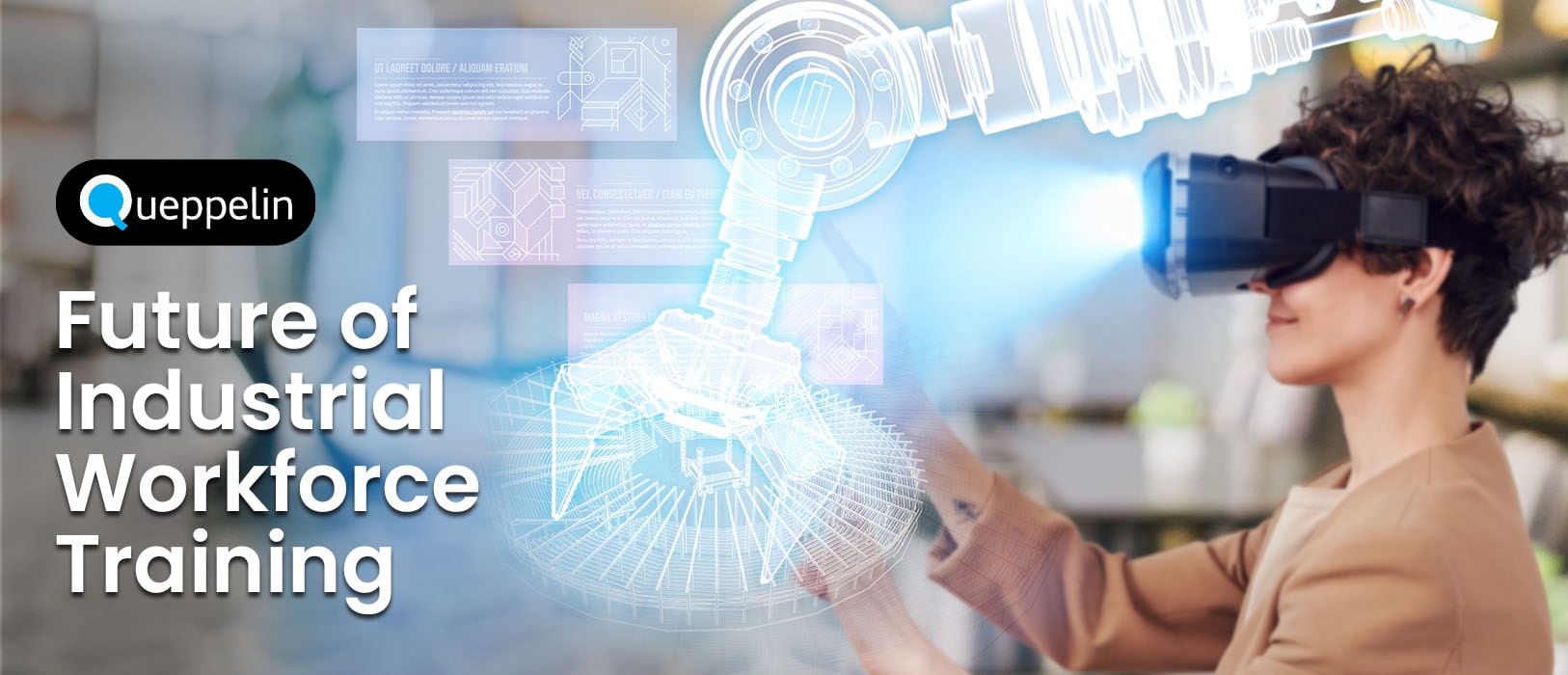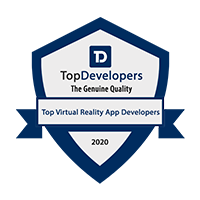The high-end technologies that hit the market in the recent few years have changed the landscape completely. They are transforming businesses, industries, and even the world. Two such amazing technologies are VR and AI.
While VR is creating a new reality altogether, AI is making machines smart and independent of human inference.
VR immersive users in an artificial three-dimensional world with the computer-generated simulation of an interactive environment that the user can navigate through, often using a headset, hand-held controllers, or other input devices.
AI makes the computer capable of understanding natural language, facilitating computer vision, and enabling it to learn from the past and make sound decisions.
They are even more impactful when combined together creating immersive, interactive, personalized, and adaptive experiences that are finding great utility in the corporate world, especially in workforce training.
They create a highly dedicated learning environment that offers greater exposure to the trainees, increases their involvement, adapts to their individual needs and offer personalized assistance, and much more.
As a result, VR trainees learn four times faster, feel more confident, achieve better learning outcomes, and perform better in their job.
In this blog, we will see the usage and benefits of bringing VR and AI to the workforce training program in detail.
Virtual Reality Training: How you can use it?
Virtual Reality training uses a computer-generated simulation of an environment or situation that mimics an on-job scenario. Trainees can interact and navigate through the scenario with a headset, hand-held controllers, or other input devices.
VR creates a sense of immersion and presence, allowing trainees to feel as if they are truly present in the working environment performing the tasks required by their jobs. For this, VR uses motion tracking, 3D modeling, and sound engineering to create a realistic experience.
Hence, VR can be used to provide accurate simulations for learning and skill development, such as flight simulators for pilot training or medical simulations for surgical training.
The fact that VR is so effective is that it creates an artificial reality that is solely focused on their learning and training. It cuts off the outside world to help them focus on the task at hand. Thereby, bringing more exposure and trainee involvement in the process.
Thereby, VR overcomes the most daunting hurdle of keeping trainees engaged in the process and making them appreciate the training. Here are some of the ways businesses are using VR in workforce training:
Virtual Reality Training Simulations:
Virtual Reality (VR) simulation training involves the use of VR technology to create a simulated environment that allows trainees to practice and learn new skills in a realistic and immersive way. This type of training is apt for scenarios wherein safety is an important consideration.
Thus, VR simulation training is used in a wide range of industries, including healthcare, aviation, engineering, manufacturing, and other such industries. It provides a safe and controlled environment for trainees to practice their skills without risk to themselves, others, or equipment.
In a VR simulation training scenario, trainees wear a VR headset or other devices that provide a 3D immersive experience. They can interact with the simulated environment using hand-held controllers or other input devices, and receive real-time feedback on their actions.
Examples of VR simulation training include surgical training for medical professionals, flight simulation for pilots, and safety training for hazardous materials handling.
Immersive and Interactive Learning:
Businesses are also using VR for immersive and interactive learning experiences to train employees in soft skills such as decision-making, problem-solving, customer handling and other cognitive abilities.
In this type of learning, the trainee is put into a scenario wherein they have to use their soft skills to achieve a certain outcome.
Here, AI plays a big role as the VR environment is designed to be interactive with realistic behavior, allowing learners to engage with and manipulate objects and surroundings, and receive real-time feedback on their actions. Trainees can also interact with virtual avatars, allowing for collaborative learning experiences and social interactions.
Remote Training:
Businesses are using VR for remote training, allowing employees to access training programs from anywhere, at any time.
In this type of training, VR training modules are delivered remotely through online learning platforms, allowing learners to access training at their own pace and convenience.
Employees can use VR collaboration platforms to connect and interact with trainers and other learners in a shared virtual environment, enabling remote collaboration and teamwork.
Lastly, VR remote assistance allows learners to connect with trainers or experts remotely and receive real-time guidance and support for specific tasks or procedures.
As evident, this type of VR training is suitable for employees working remotely such as in a different country.
After VR, let’s discuss how AI is transforming workforce training.
AI is Transforming Workforce Training with a Personalized, Data-Driven, Targeted Approach
The infusion of intelligence into machines is one of the most groundbreaking innovations, if not the most. Machines have always been faster and more productive than humans. The only thing they lacked was autonomous decision-making capability. AI gives machines this power and makes them capable to understand the world just like humans do.
In fact, AI takes machines even beyond human capabilities. Before AI, machines could only follow given instructions as they were, without adding or removing anything from their end in order to improve the success rate. To say, machines were not goal-oriented in their approach, they just followed the instruction to execute the process.
AI makes machines goal-oriented, It makes them aware of the goals they are pursuing and makes them capable to analyse whether the current process leads to that goal. And if not, they the machines are also capable of coming up with changes that can improve the process and help us meet the desired goal.
AI’s this ability to understand and suggest data-driven insightful changes makes workforce training far better than it was ever possible in the past. It makes the learning process personalized to the most granular level, offers predictive analysis, and facilitates adaptive learning and smart virtual coaching. Let’s see these in detail
Personalization
AI analyzes large amounts of data and identifies patterns to create personalized training programs for employees catering to their individual learning needs instead of using a one-size-fits-all approach to training.
AI uses various methods to identify an employee’s learning style, such as analyzing their past performance, monitoring their behavior and interactions during training, or administering assessments. Based on its finding, AI adjusts the training content to suit the needs of that particular employee. For example, if an employee is a visual learner, AI can provide more images, videos, or infographics to help them understand the training material.
Also, AI analyses data from the employee’s past performance or uses assessments to identify an employee’s strengths and weaknesses and provide targeted training to improve their skills in specific areas.
Moreover, AI continues monitoring employee performance and provides ongoing training recommendations based on their progress. This ensures that employees are receiving the training they need to improve their skills and performance over time.
Predictive Analysis
AI analyzes employee performance data such as job performance metrics, training history, and other relevant data points, AI can identify areas where employees are excelling and areas where they may need additional training and development.
With this information, AI can help organizations create targeted training programs that focus on improving the skills and knowledge of employees in areas where they need the most improvement.
For example, if AI identifies that employees are struggling with a particular skill or task, it can provide targeted training to address that specific area. This approach can help employees improve their job performance and become more productive and effective in their roles.
In addition, AI can provide ongoing monitoring and feedback on employee performance to help them stay on track with their training goals. This can include providing real-time feedback during training sessions or monitoring progress over time to ensure that employees are making progress and meeting their goals.
Adaptive Learning
AI analyzes data from an employee’s training activities, such as their responses to questions or assessments, and uses this data to adjust the difficulty level of the training program.
As an employee progresses through a training program, AI adapts the content and level of difficulty to ensure that the training is challenging, yet achievable. If an employee is struggling with a particular concept or skill, AI can adjust the training program to provide additional support or explanations to help them understand the material.
On the other hand, if an employee is progressing quickly through the training, AI can provide more advanced content to ensure that they are being challenged at an appropriate level.
Adaptive learning ensures that employees are engaged and motivated during training by providing content that is appropriate for their current level of skill and knowledge. This prevents employees from becoming bored or frustrated with training programs that are too easy or too difficult, which otherwise can lead to disengagement and a lack of retention.
Additionally, adaptive learning can help organizations improve training outcomes by ensuring that employees are developing the necessary skills and knowledge to be successful in their roles. This helps the employees reach their full potential and ultimately drives success for the business.
Virtual Coaching
AI analyzes employee performance data, such as responses to questions, interactions with virtual objects, or even facial expressions and body language. Based on this analysis, the virtual coaching system can provide the appropriate feedback to employees, helping them to improve their performance and refine their skills.
For example, if an employee is struggling with a particular task, the virtual coaching system can provide guidance and support to help them complete the task successfully. An even more interesting fact is that the system can also provide positive reinforcement when employees perform well, helping to boost their confidence and motivation.
Virtual coaching systems can be especially useful in situations where it may be difficult or impractical to provide in-person coaching or feedback. For example, in industries such as healthcare or aviation, where real-world training can be expensive or risky, virtual coaching systems can provide a safe and effective way for employees to practice and develop their skills.
The Combined Benefits of VR and AI in Workforce Training
The combination of Artificial Intelligence (AI) and Virtual Reality (VR) has transformed the landscape of employee training. By harnessing the power of AI, VR training can offer personalized learning experiences that adapt to the needs and abilities of individual learners, while providing real-time feedback and assessment.
This unique combination of technologies offers a range of benefits that can significantly enhance the effectiveness of workforce training programs. These benefits include improved engagement, customization, cost-effectiveness, and efficiency.
Additionally, the use of AI in VR training can help organizations identify knowledge gaps and provide targeted training to address specific areas of weakness. This can improve learning outcomes and ultimately contribute to the success of organizations.
Accelerated Learning Process
A PwC study found VR training can be four times faster than traditional classroom learning methods.
This is because it immerses the trainee into the learning environment cutting off all real-world distractions. The trainees are more involved in the learning session by paying 1.5 times the attention they pay in a classroom setting.
Offers Experiential Learning for Higher Confidence
In the VR training session, trainees go through experiential learning i.e. they learn by doing. This is known to be the best form of learning as they are not passively cramming the information but rather experiencing it. This leads to better conceptual understanding and longer memory retention.
Moreover, the most unique part of VR learning is the higher confidence that VR trainees exhume when it comes to applying what they learn.
As per the same PwC report, VR trainees possess 275% more confidence when it comes to applying the lesson learned through the VR sessions. This was 40% better than classroom learning and 35% better than online learning.
Improved Learning Outcomes
Studies have shown that VR training can result in higher retention rates, increased knowledge acquisition, and improved skills compared to traditional training methods.
The immersive and realistic learning environment wherein they can actively learn their lessons, and practice them multiple times in a situation that mimics the real world with real-time feedback to improve it.
Studies have shown that VR training can improve learning outcomes by up to 30% compared to traditional training methods (source: PwC).
Additionally, personalized learning experiences have been shown to lead to better learning outcomes, with learners achieving a 22% improvement in test scores compared to non-personalized learning (source: eLearning Industry).
Improved Efficiency
VR training can be more efficient than traditional training methods, as it can allow employees to practice skills and scenarios in a simulated environment without the need for physical resources or real-world risks.
The use of AI can further enhance efficiency by automating the process of analyzing employee performance data and providing feedback, reducing the need for human trainers or coaches.
Cost Savings
VR training can reduce training costs by up to 75% compared to traditional training methods (source: PwC). Additionally, the use of AI-powered training can reduce the need for human trainers or coaches, further reducing costs.
It saves costs associated with traditional training methods, such as travel expenses or the need for physical resources.
Scalability
VR training can be easily scaled to accommodate large numbers of employees, as the training can be delivered remotely and on demand. This can be especially beneficial for businesses with geographically dispersed workforces or those that need to train a large number of employees quickly.
Risk Mitigation
VR training can provide a safe and controlled environment for employees to practice skills and scenarios that may be risky or dangerous in the real world. This can help to mitigate risks to employees and to the business. For example, VR training has been used to train healthcare workers to respond to infectious disease outbreaks such as Ebola. (Source: Security Outlines)
Increased Retention
VR training can help employees to retain information and skills more effectively, as it can provide personalized and engaging learning experiences. Studies have shown that learners are 275% more confident to apply new skills after VR training compared to traditional training methods (source:PwC).
Conclusion
The combination of VR training and AI can provide a range of benefits to businesses, from enhanced learning outcomes and improved efficiency to cost savings and risk mitigation. By leveraging these technologies, businesses can create more effective and engaging training programs that help employees to develop the necessary skills and knowledge to be successful in their roles.






